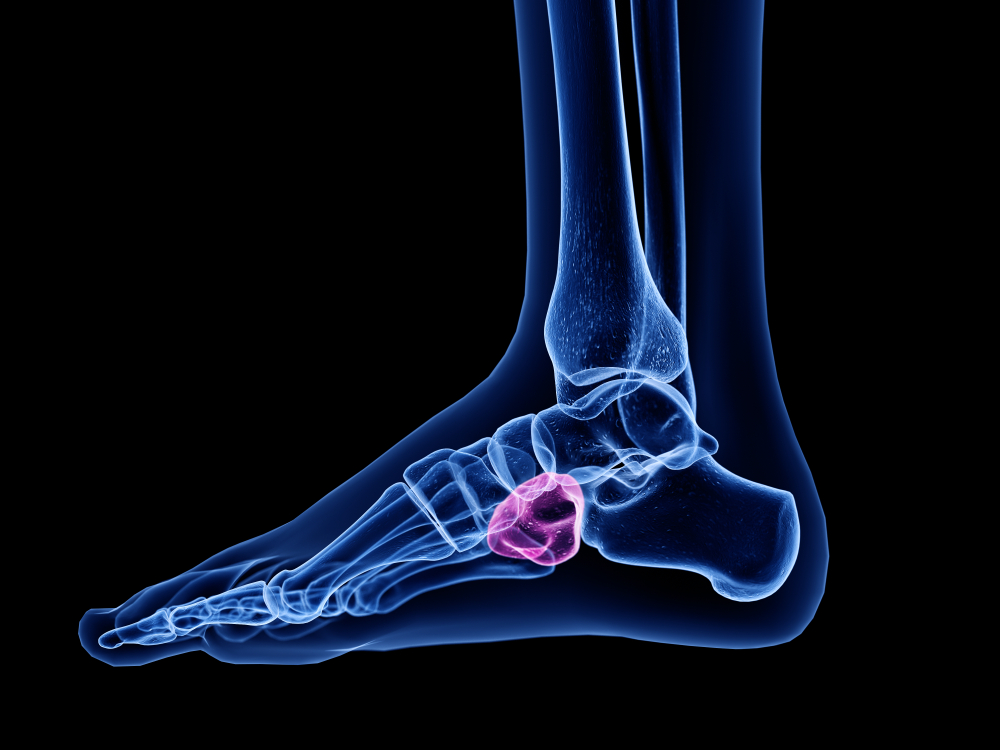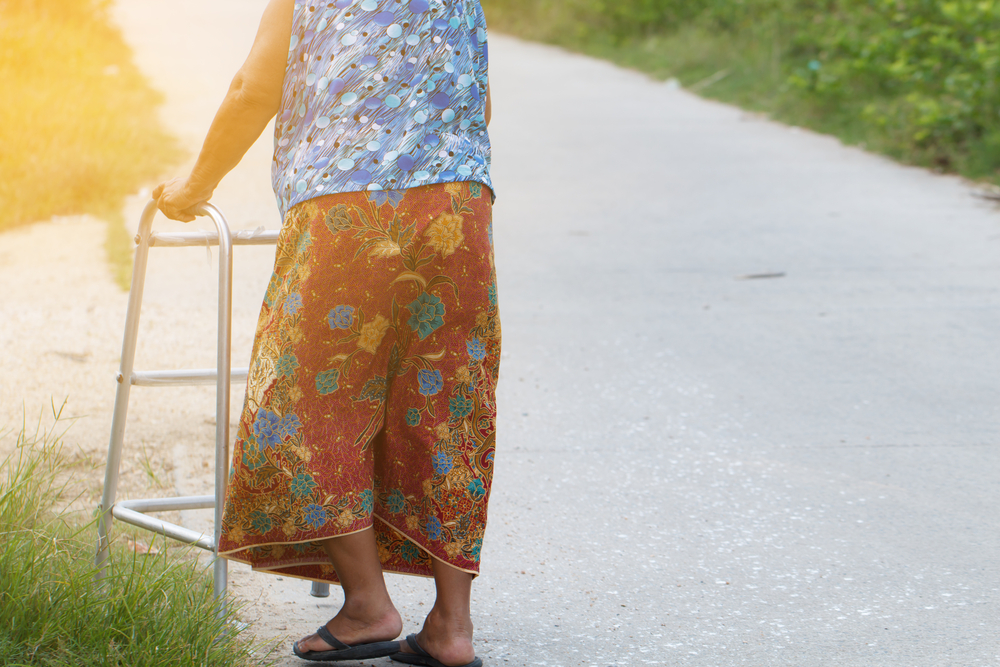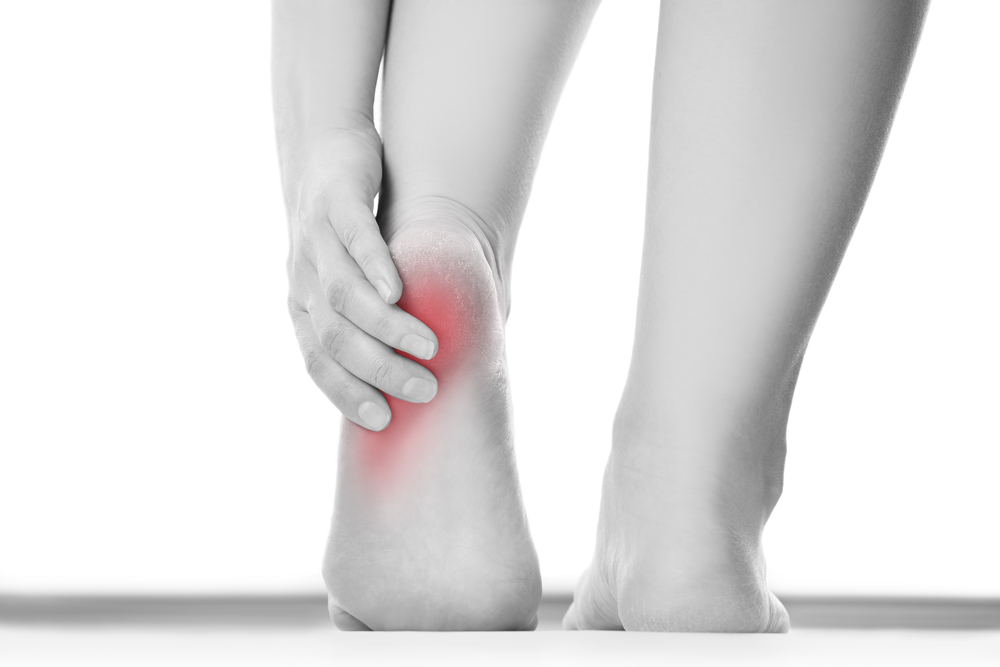 Cuboid syndrome is a condition that is caused by a partial dislocation of the cuboid bone, located in the center of the foot. When this bone is knocked out of place during an injury, it can cause symptoms such as pain along the outside of the foot, swelling, sensitivity, difficulty walking, and a reduced range of motion. Cuboid syndrome is most frequently caused by repetitive overuse during athletic activities, like tennis, basketball, or dancing. When excessive stress is placed on the feet over and over, cuboid syndrome is more likely to occur. This condition is often associated with sprained ankles. Having altered foot biomechanics, a pronated gait,or a tendency to wear ill-fitting shoes can also increase your risk of injuring the cuboid bone. If you are experiencing the symptoms of cuboid syndrome, it is suggested that you seek the care of a podiatrist.
Cuboid syndrome is a condition that is caused by a partial dislocation of the cuboid bone, located in the center of the foot. When this bone is knocked out of place during an injury, it can cause symptoms such as pain along the outside of the foot, swelling, sensitivity, difficulty walking, and a reduced range of motion. Cuboid syndrome is most frequently caused by repetitive overuse during athletic activities, like tennis, basketball, or dancing. When excessive stress is placed on the feet over and over, cuboid syndrome is more likely to occur. This condition is often associated with sprained ankles. Having altered foot biomechanics, a pronated gait,or a tendency to wear ill-fitting shoes can also increase your risk of injuring the cuboid bone. If you are experiencing the symptoms of cuboid syndrome, it is suggested that you seek the care of a podiatrist.
Cuboid syndrome, also known as cuboid subluxation, occurs when the joints and ligaments near the cuboid bone in the foot become torn. If you have cuboid syndrome, consult with Brent Harwood, DPM from Southeast Podiatry. Our doctor will assess your condition and provide you with quality podiatric treatment.
Cuboid syndrome is a common cause of lateral foot pain, which is pain on the outside of the foot. The condition may happen suddenly due to an ankle sprain, or it may develop slowly overtime from repetitive tension through the bone and surrounding structures.
Causes
The most common causes of cuboid syndrome include:
Symptoms
A common symptom of cuboid syndrome is pain along the outside of the foot which can be felt in the ankle and toes. This pain may create walking difficulties and may cause those with the condition to walk with a limp.
Diagnosis
Diagnosis of cuboid syndrome is often difficult, and it is often misdiagnosed. X-rays, MRIs and CT scans often fail to properly show the cuboid subluxation. Although there isn’t a specific test used to diagnose cuboid syndrome, your podiatrist will usually check if pain is felt while pressing firmly on the cuboid bone of your foot.
Treatment
Just as the range of causes varies widely, so do treatments. Some more common treatments are ice therapy, rest, exercise, taping, and orthotics.
If you have any questions, please feel free to contact one of our offices located in Fairhope, Brewton, and Atmore, AL. We offer the newest diagnostic and treatment technologies for all your foot care needs.
 One of the most common causes of serious injury in the elderly is falling. Among the reasons are chronic health conditions such as neuropathy (or numbness) in the feet, decreased bone density, being overweight, and reduced strength. In addition, certain medications and medical procedures can contribute to a general loss of balance. Falls at home can be prevented by making a few simple changes, such as removing throw rugs and loose carpeting, installing handrails, and wearing shoes with non-skid soles on slippery floors in your kitchen and bathrooms. Other measures include exercising to increase strength and improve balance, adequately lighting hallways, and removing clutter that is easy to trip over. Further, if your feet are frequently numb or it is painful to walk, falling may be a threat to your health. It may be a good idea to make an appointment with a podiatrist to evaluate your condition and discuss treatment options.
One of the most common causes of serious injury in the elderly is falling. Among the reasons are chronic health conditions such as neuropathy (or numbness) in the feet, decreased bone density, being overweight, and reduced strength. In addition, certain medications and medical procedures can contribute to a general loss of balance. Falls at home can be prevented by making a few simple changes, such as removing throw rugs and loose carpeting, installing handrails, and wearing shoes with non-skid soles on slippery floors in your kitchen and bathrooms. Other measures include exercising to increase strength and improve balance, adequately lighting hallways, and removing clutter that is easy to trip over. Further, if your feet are frequently numb or it is painful to walk, falling may be a threat to your health. It may be a good idea to make an appointment with a podiatrist to evaluate your condition and discuss treatment options.
Preventing falls among the elderly is very important. If you are older and have fallen or fear that you are prone to falling, consult with Brent Harwood, DPM from Southeast Podiatry. Our doctor will assess your condition and provide you with quality advice and care.
Every 11 seconds, an elderly American is being treated in an emergency room for a fall related injury. Falls are the leading cause of head and hip injuries for those 65 and older. Due to decreases in strength, balance, senses, and lack of awareness, elderly persons are very susceptible to falling. Thankfully, there are a number of things older persons can do to prevent falls.
How to Prevent Falls
Some effective methods that older persons can do to prevent falls include:
Falling can be a traumatic and embarrassing experience for elderly persons; this can make them less willing to leave the house, and less willing to talk to someone about their fears of falling. Doing such things, however, will increase the likelihood of tripping or losing one’s balance. Knowing the causes of falling and how to prevent them is the best way to mitigate the risk of serious injury.
If you have any questions, please feel free to contact one of our offices located in Fairhope, Brewton, and Atmore, AL. We offer the newest diagnostic and treatment technologies for all your foot care needs.
 Heel pain is one of the most common reasons that people seek the care of a podiatrist. Because the heel is such a foundational part of the body, there are many potential reasons that your heel may hurt. Sometimes heel pain occurs as a natural consequence of aging. The fatty pad on the bottom of the heel, which provides cushioning and protection to the heels, slowly wears away with age, increasing the risk of heel pain. Various injuries, such as plantar fasciitis, Achilles’ tendonitis, fractures, sprains, and tarsal tunnel syndrome, can also make the heel hurt. Systemic conditions, including arthritis and peripheral neuropathy, may be to blame for your heel pain. Lifestyle factors, such as wearing ill-fitting shoes or standing or exercising excessively can contribute to heel pain as well. If you are suffering from heel pain, it is suggested that you see a podiatrist for treatment.
Heel pain is one of the most common reasons that people seek the care of a podiatrist. Because the heel is such a foundational part of the body, there are many potential reasons that your heel may hurt. Sometimes heel pain occurs as a natural consequence of aging. The fatty pad on the bottom of the heel, which provides cushioning and protection to the heels, slowly wears away with age, increasing the risk of heel pain. Various injuries, such as plantar fasciitis, Achilles’ tendonitis, fractures, sprains, and tarsal tunnel syndrome, can also make the heel hurt. Systemic conditions, including arthritis and peripheral neuropathy, may be to blame for your heel pain. Lifestyle factors, such as wearing ill-fitting shoes or standing or exercising excessively can contribute to heel pain as well. If you are suffering from heel pain, it is suggested that you see a podiatrist for treatment.
Many people suffer from bouts of heel pain. For more information, contact Brent Harwood, DPM from Southeast Podiatry. Our doctor can provide the care you need to keep you pain-free and on your feet.
Causes of Heel Pain
Heel pain is often associated with plantar fasciitis. The plantar fascia is a band of tissues that extends along the bottom of the foot. A rip or tear in this ligament can cause inflammation of the tissue.
Achilles tendonitis is another cause of heel pain. Inflammation of the Achilles tendon will cause pain from fractures and muscle tearing. Lack of flexibility is also another symptom.
Heel spurs are another cause of pain. When the tissues of the plantar fascia undergo a great deal of stress, it can lead to ligament separation from the heel bone, causing heel spurs.
Why Might Heel Pain Occur?
Treatments
Heel pain should be treated as soon as possible for immediate results. Keeping your feet in a stress-free environment will help. If you suffer from Achilles tendonitis or plantar fasciitis, applying ice will reduce the swelling. Stretching before an exercise like running will help the muscles. Using all these tips will help make heel pain a condition of the past.
If you have any questions, please feel free to contact one of our offices located in Fairhope, Brewton, and Atmore, AL. We offer the newest diagnostic and treatment technologies for all your foot care needs.
 If you are a woman who loves to run, but also has bunions, it’s a good idea to reevaluate the type of shoes you are wearing. Tight shoes, especially pointed ones, can put pressure on the big toe joint and cause painful swelling. Qualities to look for in a running or workout shoe include, lightweight mesh uppers that provide comfort and allow the feet to breathe, a wide toe box that helps to accommodate the shape of a bunion, and a snug fit with proper cushioning. Preventative measures include stopping wearing high heels and pointed toe shoes, finding a bunion pad or sleeve to protect the area, and avoiding walking barefoot. In more serious cases, you may need to consult with a podiatrist who can help make custom orthotics and discuss other treatment options.
If you are a woman who loves to run, but also has bunions, it’s a good idea to reevaluate the type of shoes you are wearing. Tight shoes, especially pointed ones, can put pressure on the big toe joint and cause painful swelling. Qualities to look for in a running or workout shoe include, lightweight mesh uppers that provide comfort and allow the feet to breathe, a wide toe box that helps to accommodate the shape of a bunion, and a snug fit with proper cushioning. Preventative measures include stopping wearing high heels and pointed toe shoes, finding a bunion pad or sleeve to protect the area, and avoiding walking barefoot. In more serious cases, you may need to consult with a podiatrist who can help make custom orthotics and discuss other treatment options.
If you are suffering from bunion pain, contact Brent Harwood, DPM from Southeast Podiatry. Our doctor can provide the care you need to keep you pain-free and on your feet.
What Is a Bunion?
Bunions are painful bony bumps that usually develop on the inside of the foot at the joint of the big toe. As the deformity increases over time, it may become painful to walk and wear shoes. Women are more likely to exacerbate existing bunions since they often wear tight, narrow shoes that shift their toes together. Bunion pain can be relieved by wearing wider shoes with enough room for the toes.
Causes
Symptoms
In order to diagnose your bunion, your podiatrist may ask about your medical history, symptoms, and general health. Your doctor might also order an x-ray to take a closer look at your feet. Nonsurgical treatment options include orthotics, padding, icing, changes in footwear, and medication. If nonsurgical treatments don’t alleviate your bunion pain, surgery may be necessary.
If you have any questions, please feel free to contact one of our offices located in Fairhope, Brewton, and Atmore, AL. We offer the newest diagnostic and treatment technologies for all your foot care needs.